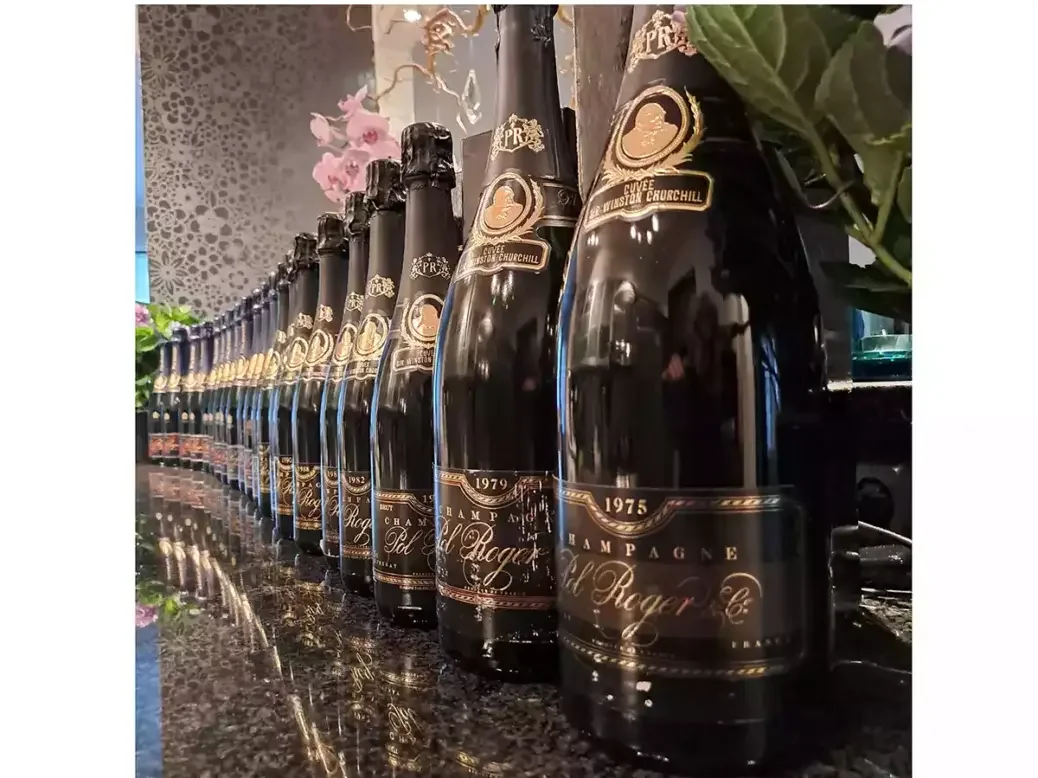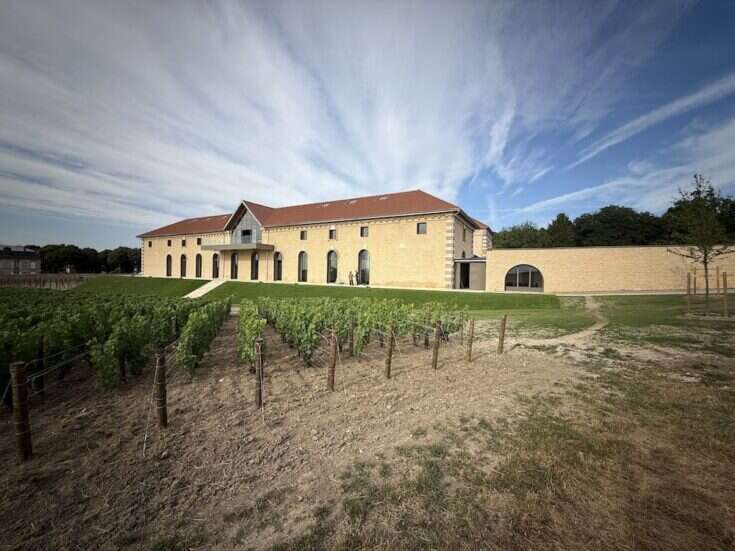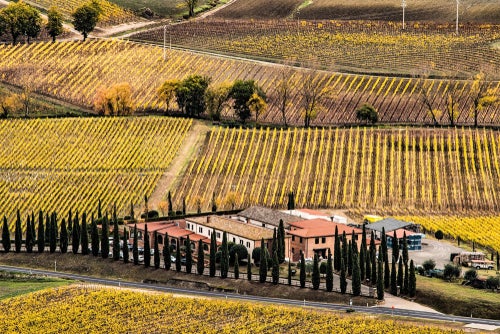
Simon Field MW reports from a thrilling tasting of all 21 released vintages of Pol Roger Cuvée Sir Winston Churchill.
Champagne imparts a feeling of exhilaration. The nerves are braced, the imagination is equally stirred, the wits become more nimble.” So said Sir Winston Churchill, in praise of his favorite tipple. And so, to Stockholm once again, one’s wits most definitely nimble in a winter that is cold even by Swedish standards. To the ancient central wine merchant Vinkällaren Grappe, and to a rare—an exceptionally rare—tasting of all 21 vintages of Pol Roger’s deluxe cuvée Sir Winston Churchill, named for you know who. This is a Champagne celebrated for its intensity, for its forthright and robust Pinot power—well named, therefore. While most deluxe cuvées (Dom Pérignon the exemplar) cleave to a Socratic balance between Pinot and Chardonnay, and many celebrate the ineluctable elegance of Chardonnay (Comtes de Champagne the flag-bearer), it falls to Sir Winston Churchill to defend the underdog, Pinot Noir. Who better? Our hostess, once again, is the redoubtable Marina Olsson, surely one of the world’s most passionate and punctilious, not to say generous and gracious, Champagne collectors. We taste the wines in six flights, semi-blind. (We know which wines are to feature in each flight, but not their running order.) Outside, it snows, but everyone is animated, all the more so because it is Nobel Prize week.
Champagne Pol Roger, initially known as Roger, was thus coined in deference to the full name of its founder, who lived from 1849 until 1899. The newly branded business was developed by Pol’s children, Maurice and Georges Roger, and is now run by members of the fifth generation. We are joined, representing the sixth generation, by Bastien Collard de Billy Pol Roger, who will, no doubt, take over in the future. Bastien is a lawyer by training (useful!) and has recently been appointed general secretary of Pol Roger (whatever that may mean). Family ownership and a close link to the United Kingdom are the corporate watchwords, he tells us. Neither is particularly fashionable in modern France. As the only Englishman in the room, I, nonetheless, cannot help but feel a tingle of pride. Champagne Pol Roger was named By Appointment to His Majesty the King, purveyor of Champagne to the royal family, in 1911. As such, Pol Roger provided the Champagne for the coronation of George V and for a great many state events thereafter.
Bastien reminds us of the gestation of the brand, of the (platonic) infatuation between Sir Winston and Odette de Pol Roger, and of his accolade, chivalrous to a fault, that took the form of naming a racehorse after her. The Champagne house returned the compliment, creating the first vintage of the eponymous cuvée (exclusively in magnum) ten years after Churchill’s death. The wine was released in 1984 at Blenheim Palace and is now, with the 2015, celebrating its 21st manifestation. The precise blend is a secret, though it is known to be majoritaire Pinot Noir, probably sourced in large part from the north-facing vineyards of Mailly and Verzenay and, to a lesser extent, from other grands crus in the Montagne de Reims, including Aÿ, Ambonnay, and Bouzy. Bastien lets slip that in more recent vintages the proportion of Pinot Noir has got close to 90%. Subtle changes, therefore, the only outward development being the shedding of the black livery of the label after a suitable period of mourning, its subsequent hue navy blue with a dark red stripe, its design based on Winston Churchill’s naval uniform.
Power and glory aside, the wines are made in the Pol Roger style, which focuses on elegance and precision. The must undergoes two débourbages (settlings), one at the presshouse immediately after pressing, and the second, a débourbage à froid, in stainless-steel tanks at 43°F (6°C) over a 24-hour period. A slow, cool fermentation, with the temperature kept under 64°F (18°C), takes place in stainless steel, with each grape variety and each village kept separate. The wine undergoes a full malolactic fermentation prior to final blending. Secondary fermentation takes place in bottle at 48°F (9°C) in the deepest Pol Roger cellars (110ft [33m] below street level), where the wine is kept until it undergoes remuage (riddling) by hand, a rarity in Champagne nowadays. Wine that has been selected for Sir Winston is aged for the longest period, initially for a whole decade, though latterly this has been reduced a little, with the latest release, the 2015, having been disgorged last year, in 2023.
A fantastic and instructive tasting
The flight patterns selected for the tasting are generally chronological, with the youngest quartet sampled first. The aberration is the shift of the 1993, so as to allow four potentially great bottles (the ’96, ’95, ’90, and ’88) to be tasted together. This is instructive indeed, though as it happens, the 1993 is the only corked bottle in the entire tasting and therefore could have been (not) tasted anywhere! Overall, a fantastic and instructive experience, with some truly outstanding wines from every decade, even if the two oldest examples (1975 and 1979) were perhaps starting to tire a little. No such issues with the very consistent trio from the 1980s, and it was encouraging that the youngest quartet was uniformly excellent, quality forcing its way from the straitjacket of youth. On the day, there was (relative) disappointment from 1998 and 2004, the more so since 2004 has been significantly upgraded of late as a vintage; superlative wines, as expected, from 2008 and 1996, with 2009 showing great complexity for the child of such a warm vintage. The two highest-scoring wines of the tasting were the aristocratic 1995, perfect to drink now, and a magnificent 2002. Often, I score 2008 over 2002, but the 2002 proved to be the better wine on the day, if one may introduce a note of relativity to a duo that flirts with absolute perfection. The elegance and complexity in play perhaps serve to remind us that there is—and probably always will be—some Chardonnay in the blend of these wines, however small a proportion. Behind the orotund and often stentorian bluster, Churchill was eloquent above all else.
Vinkällaren Grappe, Stockholm, December 9, 2023, with Marina Olsson and Gomseglet Wine & Champagne Connoisseurs
All bottles since 1995 were purchased at the time of release. All older bottles and magnums were purchased from reputable collectors. No auction purchases, no concept (yet!) of late-disgorged or oenothèque stock.

Flight 1: Cuvée Sir Winston Churchill 2015, 2013, 2012, 2009
2015
Rich gold color, with a classic aromatic of summer flowers, hazelnut, quince, and pine nuts. Behind this, hints of vanillin and Viennese patisserie. A generous and forward wine of a sunny disposition. Bright and broad it may be, but it is also composed and dignified, the exuberance of (relative) youth controlled and measured, its powder kept dry (reasonably dry) in anticipation of a long and distinguished evolution. Some find the 2015s a little structurally troubled, but there is no evidence of any anxiety here. | 93–94
2013
Still quite shy on the nose, with smoky notes (hinting at a touch of reduction) and an umami undertow. Air coaxes citric fruit, sloes, and alpine strawberries. The palate is linear and robust, not lacking for muscularity, but suitably deferential to the later cycle of this relatively cool season. Hints of nectarine and macadamia, as well as chalk and chamomile, the red fruit hitherto somewhat anonymous. Plenty more to give. | 93–95
2012
Structurally closer to the classic SWC template of quiet, building power than the younger examples: bright, with a lively mousse and hints of green behind the silvery hue. Citric, red, and yellow fruits all work together harmoniously, with a quiet rigor underpinning potential. The savory notes on the finish betray resolve and authority—boding well. | 94–95
2009
A flaxen sheen, a friendly shimmer of anticipation. A forward, generous nose, with peach and plum to the fore, celebratory of a warm and sunny vintage. Earlier to mature than some and already à point, with a rich, resonant palate, cashews and yellow fruit, a biscuity charm, and a firm but plump finish. | 95
Flight 2: Cuvée Sir Winston Churchill 2008, 2006, 2004, 2002
2008
Two things were immediately obvious when this was blind-tasted: first, that it was excellent; and second, that it was structurally (relatively) evolved, its rich color and generous, nutty aromatic both pointing toward 2002. The revelation of the identity as 2008 was quite surprising, not only to me, given the vintage’s reputation for sculptured, classical restraint. With the prize of knowledge, the linear, crystalline elegance was perhaps a little more obvious, but there was no denying the extraordinary generosity of fruit and the rich, almost gourmand profile. Magnificent now, but still, I suspect, magnificent for some time to come. | 96
2006
A generous, come-hither style, with a lively mousse and energetic bubbles. The nose and palate retreat to the breadth of the hedonist, with almond and truffle, chalk and chesterfield leather all deftly upholstering the citric core, the dosage seemingly fashioned to please le goût anglais, with a sublime combination of indolence and poise. Drinking perfectly now. | 95–96
2004
This is a vintage that has, of late, outperformed its reputation. It is disappointing, therefore, that this particular example does not quite follow the pattern. 2004 is, in any event, seen as more of a Chardonnay than a Pinot vintage. This one has quite an evolved, truffley character, cèpes and walnut and hints of beeswax, the Pinot power somewhat muffled. Fully mature now. | 91
2002
In an apparent role reversal with the 2008—in terms of expectation, at least—the 2002 is initially shy, with flinty, soft-stone notes only gradually revealing themselves and then a linear, cerebral structure, thrillingly balanced and beautifully composed. Only with a little air do the red fruits emerge, with hints of redcurrant and morello cherry, primary and precise, a gently creamy backdrop and a balletic poise underscoring the thrilling dénouement. | 98
Flight 3: Cuvée Sir Winston Churchill 2000, 1999, 1998, 1993
2000
Deep Welsh gold and a distinctive nose of gingerbread, tobacco pouch, and patisserie. The palate adds notes of honey, orchard fruit from late in the season, and even a touch of charcuterie. On a plateau and in a good place at the moment, but unlikely to get any better. | 93
1999
This is rather in the vein of 2009, a warm and sunny year, its Champagnes sometimes lacking a little tension. It is probably the case here, two decades on, and there is a slightly volatile (varnishy) feel to both nose and palate. Having said that, it does not lack for savory charm, with hints of Christmas cake, mocha, and white chocolate, and in point of fact, a very robust shard of acidity supports the ensemble. Very hard to resist today, and ideal for those who love a billowing, mature, and gastronomic Champagne. | 94
1998
A tricky year in Champagne, with botrytis frequently encountered. This example is soporific, recalcitrant at best, lacking exuberance of color and fruit, and with a vegetal backdrop that may or may not be courtesy of vestigial botrytis. Maybe a mediocre sample—or more probably indicative of a wine on a slow trajectory in a downward direction. | 87
1993
Corked. | NS
Flight 4: Cuvée Sir Winston Churchill 1996, 1995, 1990, 1988
1996
Ripe, plush, generous, and playful; the high-acid ’96s certainly take their time, and this one is no exception. There are hints of tobacco leaf and bracken behind the orchard fruits, then smoke and umami and, somewhat surprisingly, a slightly lactic, oxidative character that recalls Verdelho Madeira. Dignified and aristocratic, long and resilient. Old school. | 96
1995
An elegant, discreetly powerful ’95, its dosage (7g/l) slightly higher than today’s equivalent, which lends notes of praline and hazelnut. There are flowers here, a little wild honey and a touch of sourdough. Dried apricots and gorse, too—and behind that, peonies and hawthorn. Drinking beautifully today; the essence of a mature Pinot clearly does not have to be especially muscular, savory even. | 97
1990
Aromatically harmonious, with gingerbread and crushed flint to the fore, then macadamia and quince. Subtle tertiary notes of dried apricot and burned sugar, amertume noble, and even a touch of salinity. The finish is a little light and the mousse less persuasive than some of its peers, but there is both a freshness and a mid-palate integrity to underwrite harmony and balance and to ensure contemplative satisfaction. | 95
1988
On the edge of the abyss, its nose a little dusty, the tertiary characters of miso mushroom and crystallized, even candied, fruit on the verge of caricature. Lacks fizz and energy, but still not without a gentle, vinous charm. | 89
Flight 5: Cuvée Sir Winston Churchill 1986, 1985, 1982
1986
Pinkish hue. A meaty, umami nose, with vestigial red fruit, truffles, and crushed chalk. Hearthside and ripe plums, distinctly Aÿ, with its dark-fruit character and savory grip. There is great gastronomic potential here. The finish is tapered; one does note a touch of acetic acid, but only a touch. Not enough to undermine a positive impression and a warm, nostalgic tingle. | 94
1985
Light color, almost iridescent, with a lifted, ethereal personality. Hazelnuts and acacia, bracken and bacon fat—a fine, mature aromatic. The palate impresses most on the attack and does not lack for effervescent charm, however briefly offered. A benchmark example from a year that was always celebrated for the quality and potential of its Pinot Noir. | 95
1982
The panel was getting quite creative by this point. One advised that the aromatics of the ’82 reminded him of Old Spice aftershave; another speculated as to how Sir Winston’s jackets might smell—all Cognac, cigars, and hearthside (if not blood, toil, tears, and sweat). Be that as it may, the ’82 is evocative and complete, with yellow fruits and cèpes completing the aromatic catalog. Gentler on the palate than the ’85 and fading quite quickly, this is nonetheless an attractive, vinous style, with allusive smoky wisps lingering long in the memory. | 94
Flight 6: Cuvée Sir Winston Churchill 1979 Magnum and 1975 Magnum
1979 (magnum)
A modest hue, less amber than some at this age. A classic nose of mushroom, umami, camphor, dried fig, and orange peel, with hints of mocha, white chocolate, and a resinous character that one would not stretch to describe as acetic. A touch of rancio can be forgiven, and I do not think I agree with the taster who discerned moldy lemon! There is authority and grip, even if it is now just a little dusty on the back palate. | 90
1975 (magnum)
A deeper color than the 1979, with a luster of very old gold, maybe silver at dawn, maybe onion skin, for those of a less poetic disposition. Biscuity, with aromas of cardamom smoke; a touch vegetal. The volatile acidity makes one think that the garments are too big or too small, depending on one’s point of view. Clearly, these were once very fine and expensive garments. Broad on the attack, delicate and slightly falling away, but in a lyrical manner. Walnuts, sour honey, lemon, chocolate—not necessarily bitter chocolate. There is a little spice on the finish, which is very pleasing. | 93






